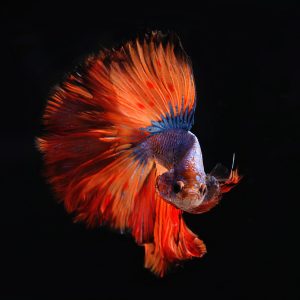
Betta fish, also known as Siamese fighting fish, originate from Southeast Asia and have been bred for over a thousand years. Initially, they were chosen for their aggressive behavior and used in fish fights, resembling cockfights. In the 19th century, their stunning colors were favored, leading to a shift towards selective breeding for aesthetic purposes. Today, they’re popular pets renowned for their vibrant hues and flowing fins.
Understanding Betta Fish
Betta fish are popular freshwater pets due to their vibrant colors and long, flowing fins. Crucial to understanding betta fish is their singular nature – they’re territorial, often preferring solitude. They thrive in warm water, need a varied diet to maintain their color vibrancy and require mental stimulation. Breathing requires access to the surface, thanks to their labyrinth organ, a feature unique to bettas.
Factors Affecting Betta Fish Prices
Several factors influence the cost of Betta fish. First, their breed significantly impacts the price; rare types tend to be more expensive. Other determining elements include coloration, tail type, age, and size. Health and vitality also play a significant role in pricing. Additionally, where you buy the Betta fish matters—imports can be costlier than locally bred species. It’s essential to consider these factors while buying a Betta fish for a fair Betta fish price.
Species and Classification of Betta Fish
Betta fish belongs to the Betta genus, which comprises around 73 recognized species. These species vary greatly in size, color, and shape, but are typically characterized by their vibrant colors and large, flowing fins. Betta fish are classified into several types based on their tail shape, including Veil Tail, Crown Tail, Halfmoon, and Delta Tail, to mention a few. They remain a beloved choice for aquarium enthusiasts worldwide.
The Uniqueness of Betta Fish
Betta fish are unique in the aquatic world due to their vibrant colors and long, flowing fins. Native to Southeast Asia, these solitary fish are renowned for their territorial and aggressive demeanor. Uniquely, they are labyrinth fish, meaning they can breathe atmospheric oxygen, allowing them to survive in low-oxygen environments where other fish cannot. Their distinct behavior and adaptability make them truly unique.
Role of Betta Fish in aquariums
Betta fish, renowned for their vibrant colors and long, flowing tails, play a pivotal role in aquariums. They add aesthetics and lively movement, enlivening the underwater scenery. Moreover, betta fish are solitary and territorial, helping to maintain certain aquatic balances. They are also robust and adaptable, often used as beginner pets for those new to aquarium keeping. These factors make bettas a popular choice for aquarium enthusiasts worldwide.
Species and color variations
Species and color variations are influenced by an array of factors including genetics, environment, and the process of natural selection. Species may evolve different colorations for numerous reasons such as camouflage, sexual attraction, or signaling to other species. The color variation within a single species can be striking, reflecting the diversity and adaptability of life on earth, an amazing testament to the power of evolution and the intricacies of ecological interactions.
Age and size of the Betta Fish
Betta Fish typically achieve full growth at around two years of age, reaching an average size of 2.5 to 3 inches. The lifespan of a healthy Betta Fish is between 3 to 5 years, but some have been known to live up to 7 years under ideal conditions. The size and age may vary according to genetics, diet, and environmental conditions, including tank size and water quality.
Health conditions of the Betta Fish
Betta fish are generally healthy and hardy but are susceptible to several health conditions. Common issues include fin rot, columnaris disease, and swim bladder disease. These conditions can be influenced by water quality, diet, and stress levels. Therefore, their environment should be closely monitored and frequently cleaned. Betta fish should be fed a balanced diet and given plenty of space to swim to maintain optimal health.

Current Market Prices for Betta Fish
Pricing in local pet stores can vary greatly depending on the products and services they offer. High-quality pet food, specialized grooming services, veterinary care, and unique accessories tend to be priced higher. Additionally, prices can be influenced by store location and competition. Despite this, many local pet stores strive to offer competitive pricing and reward programs to retain loyal customers and encourage responsible pet ownership.
Online pricing for Betta Fish
Online pricing for Betta Fish varies greatly depending on the type, color, and rarity of the species. The common Betta fish species sold online typically range from $5 to $35. However, for rare and high-quality types such as Halfmoon or Crowntail Betta fish, prices can reach up to $100 or more. Prices also often include shipping fees, which ensure safe and healthy delivery of your new pet.
Pricing trends over time
Over time, various factors influence pricing trends, resulting in fluctuations and changes. Some of these include technological advancements, increased competition, production costs, and consumer demand. For instance, improved technology often lowers manufacturing costs, which can lead to price reductions. Conversely, high demand and limited supply can cause price surges. Additionally, macroeconomic factors like inflation and economic stability also play a significant role in shaping pricing trends.
Cost Considerations When Buying Betta Fish
When purchasing a betta fish, cost considerations extend beyond the initial price of the fish. They also include expenses for a suitable tank, which should ideally be at least 5 gallons, heating equipment, fish food, decorations, water conditioner, and ongoing supplies for maintenance. Moreover, potential veterinary costs may arise. While betta fish aren’t overly expensive as pets, they still require a significant investment for proper care.
Can two female betta fish live together?
While male betta fish are known for their aggression towards each other, two female betta fish can sometimes coexist peacefully. However, this largely depends on their personalities. Some may show aggression similar to males. A larger aquarium with numerous hiding places can help, but it’s crucial to monitor for signs of stress or aggression to ensure the well-being of both fish.
Conclusion
Betta fish are certainly worth it. They bring both color and life to one’s home or office, with their vibrant hues and active movements. Plus, they are simple to care for compared to other pets – requiring only a spacious tank, regular feeding, and a clean environment. Betta fish’s playful nature and charming aesthetics can offer hours of entertainment and pleasure to fish enthusiasts and pet lovers alike.








